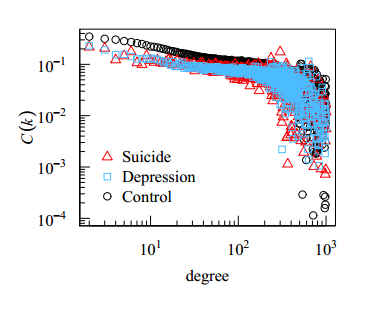| Social Networks, Suicide and Statistics |
| Written by Janet Swift | |||
| Friday, 06 July 2012 | |||
|
The data that is available in social networks is often used to detect the opinion of the crowd - but can it reveal the state of mind of the individual. New research suggests that some simple but non-obvious characteristics of social network use are related to suicide. Data mining is usually about determining things of economic advantage, but in this case, suicide we have a personal loss and an economic one. A new paper by a group of Japanese researchers, Naoki Masuda, Issei Kurahashi and Hiroko Onari, claims to have found ways of detecting suicidal tendencies - or at least the tendency to think about suicide, so-called "suicide ideation". Japan has a high suicide rate and so it is a particular problem, but the same sort of approach could be applied worldwide. The study use the Japanese social network mixi, which has over 27 million members and allows users to join any of over 4.5 million topic groups - some focusing on the subject of suicide. It seems like a reasonable if hypothesis that member of topic groups that talk about suicide tend to think about suicide and this provides an opportunity to characterise uses in terms of their tendency to think about the subject. A group of around 10,000 suicide topic members was contrasted with a control group of 200,000 non-members. The results are surprising. Seven independent variables were used in a logistic regression . Five of the variables are simple enough: age, gender, number of communities they belong to, number of friends and time of membership. The final two are slightly more complicated. Ci, the local clustering coefficient, measures the transitivity of connections. It is based on the number of triangles- A friends B who friends C who friends A - that include the user. This is a measure of how close knit the user's social groupings are.
Homophily is based on the idea that suicide is a contagious idea and it measures the relative number of friends a user has who are members of suicide topic groups. The analysis found that many of the expected relationships, such as age and gender had nothing to do with an interest in suicide. There was also no difference in the number of friends between the control and suicide group. This could just be a reflection of the fact that online friends are easy to find.The paper speculates that this may not be a reflection of the number of friends in the real world that the user has. So what are the important signs of suicide ideation? The first is the number of communities a user belongs to - the more communities, the more likely a person is to be interested in suicide. The second is the number of friend triangles they belong to - the fewer, the more interested in suicide they were. Third, and more expected, the more friends they had interested in suicide, the more they were interested in suicide. Put simply, there is a tendency for users interested in suicide to belong to more topic groups, to have fewer triangular relationships and to have more friends interested in suicide. How this study applies to similar social networks in the real world is something that needs further study. It is also clear that the same data mining methodology applied to social networks could be used to study other psychological disorders such as alcohol abuse, schizophrenia and so on.
The paper concludes with a short note on applying the same method to depression with qualitatively the same results as for suicide. More InformationSuicide ideation of individuals in online social networks (pdf) Related ArticlesTwitter Can't Predict Elections Either How the Music Flows from Place to Place
Comments
or email your comment to: comments@i-programmer.info
To be informed about new articles on I Programmer, install the I Programmer Toolbar, subscribe to the RSS feed, follow us on, Twitter, Facebook, Google+ or Linkedin, or sign up for our weekly newsletter.
|
|||
| Last Updated ( Friday, 06 July 2012 ) |



